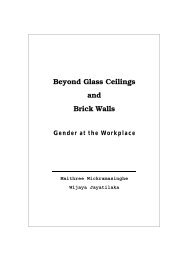SETP No. 14 The Economic Value of Incremental Employment in the ...
SETP No. 14 The Economic Value of Incremental Employment in the ...
SETP No. 14 The Economic Value of Incremental Employment in the ...
Create successful ePaper yourself
Turn your PDF publications into a flip-book with our unique Google optimized e-Paper software.
Summary and conclusions<br />
5.33 This chapter takes <strong>the</strong> results from Chapter 4 and applies <strong>the</strong>m to <strong>the</strong> national<br />
<strong>in</strong>put output relationships. From this we determ<strong>in</strong>e <strong>the</strong> multiplied impact <strong>of</strong><br />
chang<strong>in</strong>g expenditure patterns. This is done for nationally, prov<strong>in</strong>cially and for<br />
male and female headed households respectively.<br />
5.34 <strong>The</strong> focus is on poor and very poor households. For example, if household<br />
<strong>in</strong>come <strong>in</strong>creased for those people with between R1 to R5,000 a year such that<br />
<strong>the</strong>ir <strong>in</strong>come <strong>in</strong>creased to between R5,000 and R10,000 a year (and <strong>the</strong>re was a<br />
spend<strong>in</strong>g <strong>in</strong>crease <strong>of</strong> R5,000) <strong>the</strong>n, <strong>the</strong>re would be an <strong>in</strong>crease <strong>in</strong> GDP equal<br />
1.40 times this <strong>in</strong>crease, <strong>in</strong>direct household <strong>in</strong>comes would <strong>in</strong>crease by 0.65<br />
times this, 0.26 <strong>in</strong>direct jobs would be created, <strong>the</strong>re would be <strong>in</strong>creases <strong>in</strong><br />
<strong>in</strong>come tax, company tax and imports to <strong>the</strong> value <strong>of</strong> R605, R307 and R1,280<br />
respectively.<br />
5.35 At low <strong>in</strong>come levels <strong>the</strong> recorded multipliers <strong>in</strong>crease as <strong>in</strong>come <strong>in</strong>crease.<br />
Technically <strong>the</strong> cause is because <strong>of</strong> <strong>the</strong> different composition <strong>of</strong> expenditure at<br />
different <strong>in</strong>come levels. <strong>The</strong> multiplier effects cannot measure any <strong>in</strong>formal sector<br />
activity and regard all expenditure as formal. In reality much <strong>of</strong> <strong>the</strong> expenditure<br />
changes will be, <strong>in</strong>itially at least, through <strong>the</strong> <strong>in</strong>formal sector. In consequence we<br />
would expect higher <strong>in</strong>direct <strong>in</strong>come and job multipliers than are be<strong>in</strong>g reported.<br />
5.36 <strong>The</strong>re are no startl<strong>in</strong>g differences between male and female headed households<br />
or between <strong>the</strong> various prov<strong>in</strong>ces.<br />
43
















